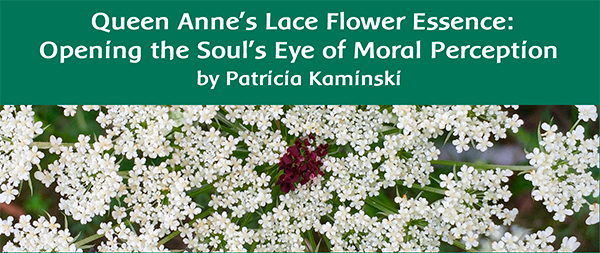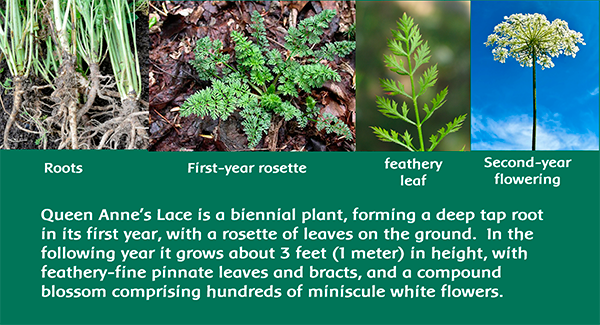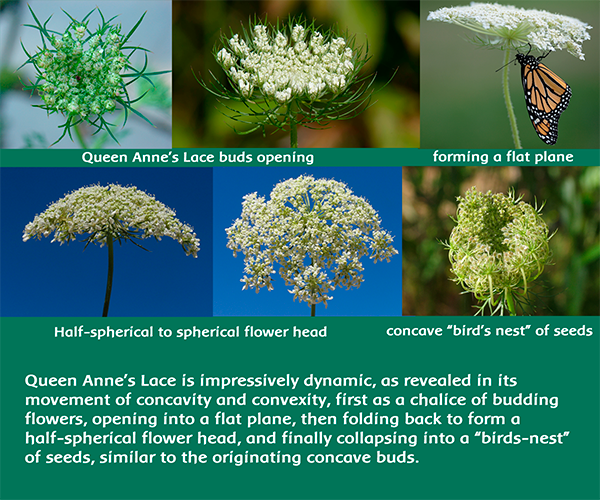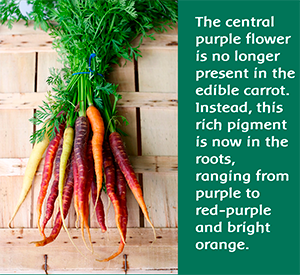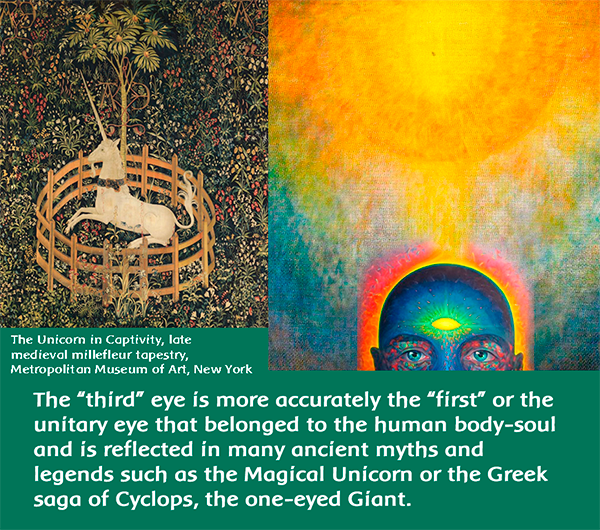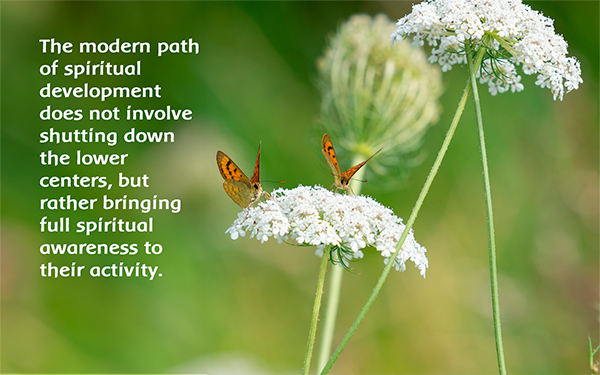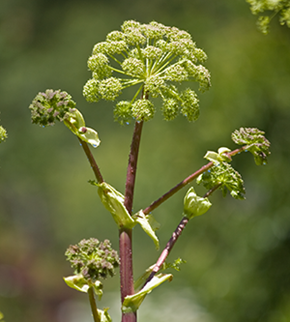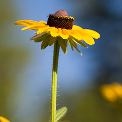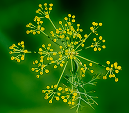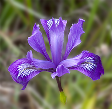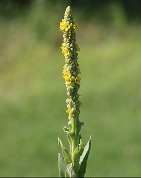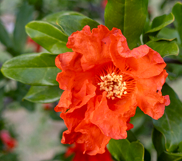|
Queen Anne’s Lace ( Daucus carota) is a wildflower we joyfully encounter in late summer. It grows in the peripheral areas of Terra Flora and all around our region, gracing country lanes, riparian pathways, and woodland meadows. Named for its exquisitely detailed lace-like flowers, it is also called Bird’s Nest or Bishop’s Lace. A biennial plant, it forms a deep tap root in its first year, with a rosette of leaves embracing the earth. In the following year, Queen Anne’s Lace grows about 3 feet (1 meter) in height, with feathery-fine pinnate leaves and bracts, and a compound blossom comprising hundreds of miniscule white flowers.
The flowerhead features an umbel-shaped cluster with a repeating fractal pattern in which the stalks radiate out from a single center point. Each of these stalks in turn leads to another radiating burst of smaller flower stalks, terminating in five-petaled flowers. Many of the flower heads have a dark purple flower in the center (it is these that we use exclusively for flower essence preparation). As the abundant seed pouch of Queen Anne’s Lace ripens, its inflorescence curls inward to form a curved cup-like shape. As we might expect, this airy plant is a host for many winged insects, especially butterflies.
The Predominance of the Air Element
Daucus carota is ruled by the Air Element. We can see this signature in its feathery leaves and intricately woven lace-like network of alabaster flowers. The diaphanous form of Queen Anne’s Lace invites the whole plant to be breathed through with air and light. Even the stem of Queen Anne’s Lace is hollow, so that the air circulates and suffuses its internal cellular tissue. Furthermore, its growth pattern is skyward, flowering when dry, sunny conditions especially favor the air element.
The airy structure of the Queen Anne’s Lace allows light to penetrate the plant and exert precisely articulated formative forces. It is impressively dynamic, as revealed in its movement of concavity and convexity, first as a chalice of budding flowers, opening into a flat plane, then folding back to form a half-spherical flower head, and finally collapsing into a “birds-nest” of seeds, similar to the originating concave buds. As a biennial, the Queen Anne’s Lace plant develops a fierce connection to the earth, with a strongly anchored taproot during its first year of growth. This vigorous central tap root gradually develops a finely attenuated system of spreading roots, enlivening and aerating the soil. The root system of the mature Queen Anne’s Lace plant is so vital that it can easily survive with little water and in poor soils, while continuing to produce ample flowering activity through the long, hot days of summer.
History of Herbal Healing for the
Daucus carota is generally associated with healing benefits for the genitourinary-kidney system – a complex of biological and physiological forces traditionally ruled by the Air Element. The first known written description is in the third century BC by Diphilus of Siphnos, citing its diuretic properties. Other ancient herbal uses include an infusion of its leaves to prevent or treat kidney-stone formation, and combat cystitis. Daucus carota was regarded as an effective remedy for kidney, bladder, and menstrual ailments, as well as dropsy, flatulence, and edema. Greek healers used the seeds of this plant for their anti-fertility properties and their role as emmenagogues. Similarly, in Roman culture, the wild carrot was used for contraception, believed to prevent implantation by stimulating the uterus. In more recent herbal history, various preparations of Daucus carota have been employed in the treatment of urinary calculus, cystitis, gout, prostatitis, and related cancers. The essential oil of the wild carrot oil has been used as an antiseptic and anti-inflammatory agent for prostatitis and cystitis. The Development of Daucus carota into an Edible Food with Exceptional Capacity for Pigmentation
The root is not normally an expression of the light-sensing photosynthetic process, and yet remarkably it is these very qualities of light and color that have been re-directed in the modern-day edible carrot. An interesting experiment that one can perform with the fresh flowerhead of Queen Anne’s Lace is that of dipping it into another color, such as red beet juice. The flowerhead will immediately absorb and become saturated with this new color. This exceptional capacity for pigmentation is unique to Daucus carota and helps one to understand how these qualities were gradually developed into its colorful and edible roots. Carotenoids, such as alpha- and beta-carotene, were first discovered in carrots (hence their name). Carotenoids are pigment compounds that give carrots their vibrant colors and nutritional strength. These pigments are what make carrots one of the most nutritious of foods, richly endowed with provitamin A carotenoids that are converted into vitamin A, with deep orange carrots being the most nutritious of all. It is Vitamin A that is uniquely able to nourish the pigment in the retina of the physical eye, as well as benefiting the skin with retinol compounds, and the soft tissue and the immune system in general. The Purple Eye of Queen Anne’s Lace: Understanding its Healing Properties as a Flower Essence The unique capacity of the Wild Carrot to become an edible food with nutritional qualities that nourish the physical eye, can help us understand its original, archetypal healing qualities. The purple eye of Queen Anne’s Lace is related to the spiritual center of the human soul, called the third eye. This “third” eye is more accurately the “first” or the unitary eye that belonged to the human body-soul and is reflected in many ancient myths and legends such as the Magical Unicorn or the Greek saga of Cyclops, the one-eyed Giant. This primal, single eye of the human being was completely clairvoyant and united with higher spiritual realms (thus “single” in sight).
The path of physical incarnation and individuation necessitated the human experience of duality as encountered on present-day earth, with its polarities of light and darkness, spirit and matter. Gradually, the primordial clairvoyance of the “third” eye became a dormant vestigial organ, replaced by two eyes for physical sight. This helps us to appreciate how the original, inherent spiritual qualities of the wild Daucus carota could be re-channeled into an outstanding physical food so beneficial to human eye nutrition. In our age, the human soul is entering a new cycle of evolution, regaining spiritual consciousness, but now with individuality intact rather than merged unconsciously with the spiritual world as it formerly was. Queen Anne’s Lace is one of the flower essences that helps to balance and integrate these emerging states of spiritual awareness.
The Botanical Family of the
Umbelliferae
:
Queen Anne’s lace is a notable member of the botanical family of the Umbelliferae , or Apiaceae , chiefly characterized by its affinity for the Air Element. Many of its members have carminative and digestive properties on the physical level, literally balancing excess air, or flatulence, and related forms of swelling that cause water retention and lymphatic sluggishness. Outstanding examples of Umbelliferae plants with these healing qualities include parsley, celery, dill, fennel, caraway, anise, chervil, coriander and cilantro. Our research shows that certain members of the Umbelliferae family work at a higher level of soul healing when formulated as flower essences. This involves building a bridge from sensory awareness to spiritual consciousness. Dill flower essence , for example, is excellent for calming overwhelm, chaos and excess stimulation of the nerve-sense system. It is a particularly important remedy for those who are sensitive or allergy prone, and an excellent foundational remedy for children who are bombarded by excessive sensory stimulation to the nervous system through technology and constant movement. Angelica flower essence is a fundamental remedy for expanding consciousness beyond a pervasive, isolating perception of a purely physical world. Through Angelica, soul awareness is lifted and refined, gradually becoming receptive and cognizant of higher worlds, especially the immediately bordering angelic realm.
Queen Anne’s Lace Flower Essence:
A predominant healing quality of the Queen Anne’s Lace flower essence involves balancing the polar relationship between the physical senses and soul consciousness. For example, the Queen Anne’s Lace flower essence can be very helpful for those who suffer from a variety of disturbances in the physical eyesight, especially when the body and soul struggle between unconscious clairvoyance and related psychic experiences, and what is objectively perceived and understood through the conscious mind. Bringing awareness to forces projected into the personality through lower desires At a deeper level, this struggle for insight and objectivity can lead to a condition called “psychic projection.” Here the personality can be tempted to substitute its own subjectively distorted sense of self-image, rather than the objective reality or truth of one’s situation. This seeing often involves a struggle with consciousness related to the lower “life pole” energy centers of the body/soul. For example, certain aspects of the personality, particularly with regard to one’s sexual and other desire-based behaviors, may assume unlawful or untruthful presentation. This is a phenomenon well-documented in our modern-day world of political, spiritual or cultural leaders who may publicly project a “higher” personality, and yet have another hidden side of behavior that runs counter to the more ideal self that has been imaged into the public arena. Though we can be aware of extreme examples in popular culture, the temptations are common to all who work to unfold higher centers of awareness. As the soul struggles for a more spiritualized form of consciousness, many aspects in the sense/desire nature of the personality must be consciously recognized and brought into harmony with the upper spiritual centers of consciousness. This is why, in traditional spiritual development, the aspirant typically removes her/himself from secular culture and seeks spiritual refuge, along with taking vows of poverty, chastity and obedience.
Greater attunement and direction of
Through external measures in traditional spiritual and religious practices, the lower chakras were effectively regulated, or even silenced, so that the upper chakras could be harmoniously and safely opened. This is related to one of the herbal properties long associated with Queen Anne’s Lace, involving its use as a natural contraceptive, thereby subduing some of the strong and overpowering reproductive forces of the second chakra. Many women have reported that use of the Queen Anne’s Lace flower essence helps them be more attuned to and able to regulate, harmonize and re-direct their reproductive forces. This use is related to the ancient Chinese herb, Dong Quai (Angelica sinensis), a close botanical cousin often called “female ginseng” for its salutary benefits on the entire female reproductive system, harmonizing both physical and soul qualities. Harmonious opening toward new modern forces of soul consciousness In our modern age, spiritual opening is possible, alongside daily life responsibilities of work and family. In fact, the modern path of spiritual development does not involve shutting down the lower centers, but rather bringing full spiritual awareness to their activity. We cannot congruently develop higher chakras of perception—especially the energy center that is called the third eye—unless we recognize and take responsibility for the soul’s desires and passions that are operative in the life/metabolic centers. If the spiritual eye is opened unlawfully through spiritual ambition, personality projection, psychic techniques devoid of moral awareness, or drugs; this can cause harm or negative effect to oneself or others. With its ability to integrate both earthly and cosmic poles into dynamic and creative unity, Queen Anne's Lace is an outstanding flower essence for harmonious integration and gradual development of soul consciousness and sensory awareness.
Beneficial use of the
Umbelliferae
Trine of
We can also see the important role of the two other Umbelliferae flower essences that are often used with Queen Anne’s Lace to provide harmonious fusion of the upper and lower poles of the body soul matrix. Angelica flower essence activates the higher awareness of our spiritual faculties so that we feel the protection and guidance of the “guardian angel” or “spiritual witness,” who is there to help fuse the lower personality with the higher. The Dill flower essence regulates and harmonizes the nerve-sensory impressions we take in, so that they are “digested” and assimilated in the soul consciousness.
Distinguishing Queen Anne’s Lace
Queen Anne’s Lace is commonly used with other related flower essences. It is valuable to understand its unique qualities in comparison with these essences.
Further study: Read Theresa Melia’s study of the Queen Anne’s Lace submitted as part of the FES Practitioner Certification Program. |
||||||||||||||||||

To install this Web App in your iPhone/iPad press ![]() and then Add to Home Screen.
and then Add to Home Screen.
